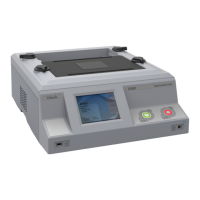C H A P T E R 1 4 - A T E D I T OR
AT5600 User Manual 98-119 issue 14 Page 329
What happens if I set both absolute limits for both primary and
secondary windings?
If you want to detect up to a 10 turn error on the primary and 1 turn on the
secondary in the above example, set 91/2 (pri) and 1/2 (sec).The tester uses the
equivalent ratio limits: 21.95 and 18.05. Setting both limits WIDENS the limit to
allow for an error of 10 Turn on the primary SIMULTANEOUSLY with 1 turn
on the secondary.
i.e. to allow 190:11 (17.27) and 210:9 (23.33).
Notice that these limits will NOT detect just a 1 turn error on the secondary
because you have now chosen limits to allow for errors on both primary and
secondary, resulting in a broader tolerance on the absolute ratio.
How so I set limits that will detect a 1 turn error in either the primary or
secondary winding?
To do this you must set limits that will detect the smallest possible error. This
will be due to the 1 turn error being on the winding with the largest number of
turns.
In the above example, then, set absolute limits of ½ turn (pri) and 0 turn (sec)
(Remember to use the n-1/2 rule).
The equivalent limits used by the tester will be:
20.05 and 19.95
This will certainly detect a 1 turn error in the primary, but because of the physical
errors already described these limits may be too severe for a normal good part.
This is why a combination of inductance and turns ratio tests are normally used
to confirm the correct assembly of transformers.
The polarity test may be selected as (+)ve, (-)ve or no test. To measure the exact
interwinding phase angle use the PHAS test.

